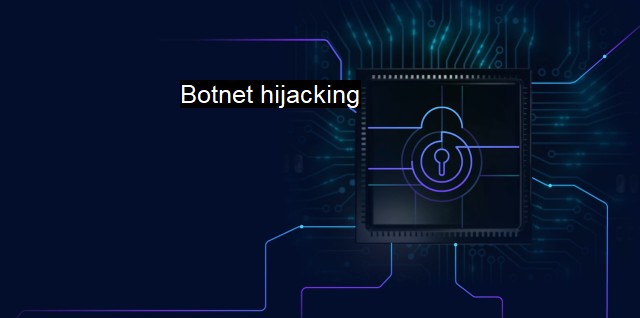What is Botnet hijacking?
The Unseen Danger: Botnet Hijacking and the Need for Improved Antivirus Solutions in the Modern World of Cybersecurity
Botnet hijacking refers to the malicious activity of taking control over a group of interconnected devices, known as a botnet, without the consent of the system's authorized user. Let's delve deeper into this cybersecurity concern with a particular focus on its definitions, features, origin, strategies, preventive measures, and future implications.A botnet is a cluster of internet-connected devices, which may include PCs, servers, mobile devices, and internet of things devices that are infected and controlled by a common type of malware. Each compromised device, known commonly as a 'bot', is created when a device is penetrated by the attacker, who subsequently gains control over the device. The botmaster or bot herder controls these botnets, which can leverage thousands to millions of bots. They operate undetected, carrying out malicious activities in the background.
The advent of Botnet hijacking originated with the inception of the Internet and significantly amplified with the increasing operations of cybercriminal activities. Cybercriminals aim at harnessing the mass scale of these botnets to perform various malevolent operations. They can direct these hordes of compromised systems to perpetrate distributed denial-of-service (DDoS) attacks, steal sensitive data, deliver spam, or allow the attacker to access the device and its connection. Botnet hijacking is a significant cybersecurity risk as it potentially fuels large-scale, coordinated cybercrimes that can bring massive disruptions at both individual and enterprise levels.
The hijacking process begins with the attacker identifying and exploiting vulnerabilities in a computer's security system: this could be through a phishing email, a malicious website, or security gaps in software. Once control is assumed, the bot is added to the bot-net pool, and the attacker coordinates various operations through a Command and Control (C&C) server. This server sends instructions to each bot — individually or in aggregate. These instructions can include directions for DDoS attacks on specific targets or commands to propagate the malware and thus broaden the botnet.
The features of botnet hijacking make it a more complex threat than individual device compromises. Intricate command and control structures, rapid propagation mechanisms, and the capacity to remain undetected increase their risks substantially. botnets can be rented out in the black market, making them available to a broad audience and difficult to trace back to a single entity.
To counter botnet hijacking, many mitigation strategies run both on proactive and reactive fronts. Proactive approaches are prevention-driven, aiming to secure devices from becoming part of a botnet in the first place. Device owners should maintain up-to-date antivirus software, keep operating systems and applications patched promptly, use strong, unique passwords, and abstain from clicking suspicious URLs or email attachments. Meanwhile, reactive measures are undertaken after a detection, including threat hunting, isolating infected systems, analyzing malware behavior, removing malware, and restoring the systems.
The future impacts of botnet hijacking are intertwined with the evolution of technology and cybersecurity. As botnet structures become more complex and robust, they will pose increasing difficulties in mitigation and elimination. More sophisticated botnets, together with an increasing number of internet-connected devices, provide attackers with immense networks to expand their activities.
Adequate knowledge, awareness, and preparedness can equip users with the necessary skills to stay safe. Various cybersecurity solutions are enhancing their countertactics - deepening their insights into botnet behaviors, improving their detection capabilities and mitigating potential threats. Cybersecurity education and investment will also play a critical role in curbing this menace, emphasizing the importance of user diligence and sound, updated security practices.
Botnet hijacking is an evolving threat in the computing world, continually morphing and adapting to conceal its traits and maximize its damaging effects. Increasing awareness about its mechanisms, staying up-to-date with security patches and antivirus software, and following best security practices can diminish the success rates of these hijacking attempts, contributing to a safer cyber environment for all users.

Botnet hijacking FAQs
What is botnet hijacking?
Botnet hijacking refers to the act of taking control of a network of compromised devices or computers, also known as a botnet, for malicious purposes.How do cybercriminals use botnets for their advantage?
Cybercriminals can use botnets to launch large-scale attacks such as DDoS attacks, spam campaigns, and malware distribution. They can also sell or rent access to the botnets on the dark web for profit.What are the signs that my device is part of a botnet?
Some signs that your device might be part of a botnet include experiencing slow performance, unusual network activity, unexpected pop-ups, and unauthorized access to your files or personal information.How can I protect my device from botnet hijacking?
To protect your device from botnet hijacking, you should keep your antivirus software up-to-date, install software updates as soon as they become available, and be cautious when clicking on links or downloading attachments from unknown sources. Additionally, you can use a firewall and limit the use of IoT devices in your network.| | A | | | B | | | C | | | D | | | E | | | F | | | G | | | H | | | I | | | J | | | K | | | L | | | M | |
| | N | | | O | | | P | | | Q | | | R | | | S | | | T | | | U | | | V | | | W | | | X | | | Y | | | Z | |
| | 1 | | | 2 | | | 3 | | | 4 | | | 7 | | | 8 | | |||||||